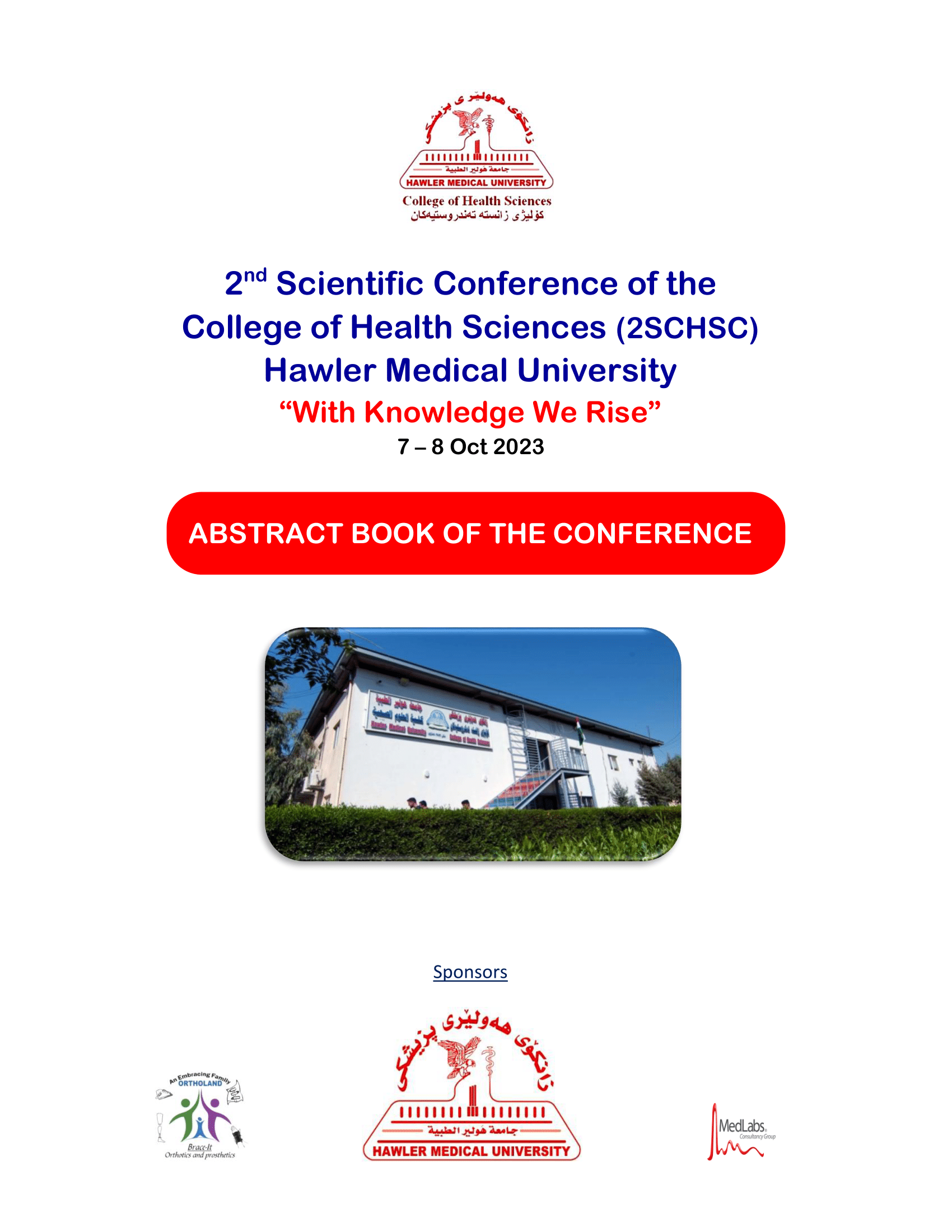A Novel Production of Multiple Phyto-Nanoparticles and Their Activity as Anti Head Lice and its Overlapping Bacteria
DOI:
https://doi.org/10.15218/hcchs.2023.04Keywords:
Nanotechnology, Henna, Lawsoniainermis, Spectroscopy, BabylonAbstract
Background and objective: Nanotechnology is defined as a highly developed technology due to its wide range of applications in various fields of medical science, technology, and other research fields. Green synthesis methods are environmentally friendly, readily available, safe and non-toxic. The Objective of the present study is to producing nanoparticles from plant in addition to evaluation the effectiveness of the extracted nanoparticles as anti head lice and it is overlapping bacteria.
Methods: In this study, several nits were collected and more than 44 adult lice were screened for bacteria. Ethanol and Deionized water was used to obtain nanoparticles from Henna leaves, Lawsonia inermis. The characterization process was performed using UV-visible spectroscopy techniques, energy dispersive X-ray spectroscopy (EDX) and atomic factor microscopy (AFM). Pharmaceutical activity of the isolated nanoparticles was determined through using of agar diffusion test and in vitro study of the nit embryonic development.
Results: The results of the study include the identification of several nanoparticles from Henna leaf extract, including cadmium, iron, nickel, zinc, copper, cobalt, manganese, and silver, with different concentration density ranged from 10 nm to 50 nm, with a percentage of 80%. Obtained nanoparticles (especially 15μL in concentration) can penetrate the wall of the nit shell and reach the embryo followed by inhibition of it is growth also play a powerful role in eliminating and inhibiting the lice overlapping bacteria.
Conclusion: Development of a new drug product to treat and control the growth of head lice Phyto-multinanoparticles- is play a strong role in the eradication and inhibition of the nits and lice overlapping bacteria.
References
Biswas K, Chattopadhyay I, Banerjee RK, Bandyopadhyay U.Biological activities and medicinal properties of neem (Azadirachtaindica). 2022; Currnt Sci., 82(11): 1336-1345.
Chaudhary G, Goyal S, Poonia P.LawsoniainermisLinnaeus: A phytopharmacological review. 2010; Int J PharmaceutSci Drug Res., 2(2): 91-98.
Haleema A, Javaida M, Pratap SR, RabcSh, Sumand R. Applications of nanotechnology in medical field: a brief review. 2023. Global Health J.; 7(2): 70-77. Doi: org/10.1016/j.glohj.2023.02.008.
Khan IA, Saeed KH B, Khan I. Nanoparticles: Properties, applications and toxicities. Arab J Chem. 2019; 12 (7): 908-931. doi: org/10.1016/j.arabjc.2017.05.011.
Giri VP, Shukla P, Tripathi A, Verma P. Kumar N, Pandey SH., Dimkpa CH O, Mishra A. A review of sustainable use of biogenic nanoscale agro-materials to enhance stress tolerance and nutritional value of plants. 2023; Plants J., 12 (815): 1-27. doi: org/10.3390/plants12040815
Prerna, Dubey A, Gupta R. Nanoparticles: an overview. Drugs and Cell Thera in Haem. 2021; 10 (1): 1487 -1497.
Augustine R, Hasan A. Multimodal applications of phytonanoparticles.JMicro and Nano Tech. (2020): 195-219. doi:org/10.1016/B978-0-12-822348-2.00011-5.
Hajji Nabih M, Boulika H, El Hajam M, Alghonaim MI, Kandri NI, Alsalamah SA, Boufahja F. Successive solvent extraction, characterization and antioxidant activities of cardoon waste (leaves and stems) extracts: comparative study.2023; Molec J., 28 (1129): 1-11. Doi:org/10.3390/ molecules28031129.
Quevedo OC, Guggenheim E, Briffa SM, Adams J, Lofts S, Kwak M, Lee GT, Johnston C, Wagner S, Holbrook TR, Hachenberger YU, Tentschert J, Davidson N, Valsami-Jones E. UV-V is spectroscopic characterization of nanomaterials in aqueous media. J.Vis. Exp.2021. (176), e61764. Doi:10.3791/61764.
Scimeca M, Bischetti S, Lamsira HK., Bonfiglio R, Bonanno E. Energy dispersive x-ray (edx) microanalysis: a powerful tool in biomedical research and diagnosis. Europ J of Histochem.2018; 62(2841): 1-10.Doi:10.4081/ejh.2018.2841.
Grobelny J, Delriowf. Pradeep N, Kim D, Hackley, VA, Cook R. Size measurement of nanoparticles using atomic force microscopy. 2009. J. Meth Molec Biol., 1(1): 1-20.Doi: 10.1007/978-1-60327-198-1-7.
Sonnberg S, Oliveira FA, Araújo De Melo I, De MeloSoares MM, Becher H, Jorg H. Ex vivo development of eggs from head lice (Pediculushumanuscapitis). The Open Dermatol J.2010; 4 (83): 82-89.
Al-Marjan KS, Ahmed HF, Kamel FH. Evaluation of efficiency of silver nanoparticles for the diagnosis of intestinal parasites, isolated from displaced children in Kirkuk Province-Iraq. Mousl J Nurs. 2019.; 7(2). doi: 10.33899/mjn.2019.174835.
Mollea CH, Bosco F, FissoreD. Agar plate methods for assessing the antibacterial activity of thyme and oregano essential oils against S. epidermidis and E. coli. J Antibiotics. 2022. 11 (1809): 1-14. Doi:org/10.3390/antibiotics11121809. 15. Farooqui MA. Chauhan PS, Krishnamoorthy P, ShaikJ. Extraction of silver nanoparticles from the leaf extracts of Clerodendruminerme. 2010; Digest J Nanomaterials and Biostructures, 5(1):43-49.
Xue PJ, Zhu Y, Bai SH, He, Du G, Zhang Y, Zhong Chen W, Wang H, Sun X. Nanoparticles with rough surface improve the therapeutic effect of photothermal immunotherapy against melanoma. Acta Pharm Sinica B J.2019; 12(9). P.3639-36-49. Doi: org/10.1016/j.apsb.2022.02.006.
Al-Marjan KS, Koyee QM, Abdullah, SM. In vitro study of the morphological study of egg (nits) and other stages of the head lice, Pediculiushumanuscapitis. Zanco J Pure Appl Sci.2015; 27 (3): 35-40.
Sun Y, Chen, D. Pana Y, Qua W, Haoa H, Wang X, Liu XH, Xie SH. Nanoparticles for antiparasitic drug delivery. J Drug Delivery.2019; 26, (1): 1206–1221. doi: org/10.1080/10717544.2019.1692968.
KandeelM, Rehman T, Akhtar T, Zaheer T, Ahmad SH, Ashraf U, Omar M. Anti-parasitic applications of nanoparticles: A Review. 2022. Pak Vet J.; xxxx, xx(x): xxx. doi: 10.29261/pakvetj/2022.040.
Al-Bazaz FA, Radhi NJ, Hubeatir KD. Sensitivity of Streptococcus mutansto selected nanoparticles (in Vitro Study). J BaghColl Dentis.2018; 30 (1): 69-75. doi: org/10.12816/0046315.
Alsultany SH, Mohaimeed AA. Role of nanoparticles synthesized from bacteria as antimicroorganism: a review. Iraqi J Nanotechn, synth and appli. 2021; 2 (2021).:44-53. doi.org/10.47758/ijn.vi2.41.
Al-Nema LM, Al-Ali AA. Antifungal activity of Magnesium oxide and Zirconium oxide nanoparticles incorporated into alginate impression material. In vitro study. Al-Rafidain Dental J. 2020; 22, (2): 343-351.
Downloads
Published
How to Cite
Issue
Section
License
Copyright (c) 2025 Karwan Sallo Najm AL-Marjan, Fouad Hussain Kamel, Shamall M.A. Absullah

This work is licensed under a Creative Commons Attribution-NoDerivatives 4.0 International License.











